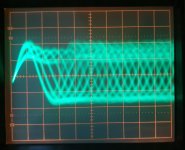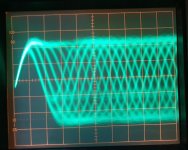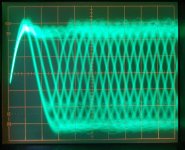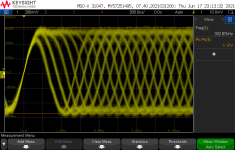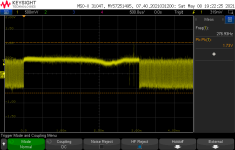From when I was newbie here and I recall @anatech helping me figure out how to attach images for these  Long time ago.
Long time ago.
https://www.diyaudio.com/community/threads/test-cd-for-cd-player-adjustment.67783/post-1415445
https://www.diyaudio.com/community/threads/test-cd-for-cd-player-adjustment.67783/post-1415445
Checked the cd and no disc rot.Some old CD's (and I've seen this on Deutsche Gramophon in particular) can suffer from 'disc rot'. If you hold the disc up to a bright light you can see the mottled appearance if you look through the disc at the light. The silver layer also can look discoloured.
Funniest thing is that this is the only cd with problems while playing, until now.
Tried a new cd (kiss remaster) and jumped. It jumps forward…. The seconds shown on screen are going too fast because of track jumping.
Adjusted the focus a little bit (+50mV) and worked. I’ll cross fingers.
Now the average mV is not 400. It’s about 500mV.
The discs that present the most problems are those in which the RF signal is more shaky.
The bad thing is that there is no way to correct this tremor.
When you keep referring to 'Focus', are you meaning the 50mv across the resistor R3501. If so then that reading is only related to the laser power.
Focus as a voltage which is applied to the focus coil will vary a little according to each disc and depends on how near or far the reflective layer is from the lens. If one disc needs 350mv and one needs 500mv then that is what they need to position the lens in the correct position and that is determined by the servo.
Focus as a voltage which is applied to the focus coil will vary a little according to each disc and depends on how near or far the reflective layer is from the lens. If one disc needs 350mv and one needs 500mv then that is what they need to position the lens in the correct position and that is determined by the servo.
No, the laser power is ok.
Im referring to focus because is the only thing I had troubles to adjust.
When I thought it was well adjusted, I noticed some track jumps in 1 or 2 cd’s.
Then I increased a little bit the focus pot. Now track jumping has gone. Well…. I think so. I’ll cross fingers while future listenings.
Im referring to focus because is the only thing I had troubles to adjust.
When I thought it was well adjusted, I noticed some track jumps in 1 or 2 cd’s.
Then I increased a little bit the focus pot. Now track jumping has gone. Well…. I think so. I’ll cross fingers while future listenings.
ThanksIm referring to focus because is the only thing I had troubles to adjust.
I've looked at the circuit closely and it seems to be a DC adjustment to get the range of focus operation to be roughly centered in the middle of the focus error amps range (not the focus coil drive amp). Many Philips players do not even have that adjustment and just have it at a fixed value.
I also found this:
https://www.diyaudio.com/community/threads/intermittent-problem-philips-cd150.362840/
I have this CD nearly impossible to play:
https://www.discogs.com/release/7480130-Johann-Sebastian-Bach-Miklos-Spanyi-From-Das-Orgelbuchlein
I measured the eye pattern an it is about half of any other normal CD. It is even lower than that of a CD-R. One literally can see through it.
https://www.discogs.com/release/7480130-Johann-Sebastian-Bach-Miklos-Spanyi-From-Das-Orgelbuchlein
I measured the eye pattern an it is about half of any other normal CD. It is even lower than that of a CD-R. One literally can see through it.
Hi lcsaszar,
lol!
Frame it as an example of a really bad CD pressing.
CD-R are totally different. Normal CDs are pressed, then metallized. CD-R discs depend on the laser to burn the coating so it doesn't reflect. There are so many differences between them that CD player manufacturers do not warranty their machines will read a CD-R. They usually do, but HF level may be well out of spec.
lol!
Frame it as an example of a really bad CD pressing.
CD-R are totally different. Normal CDs are pressed, then metallized. CD-R discs depend on the laser to burn the coating so it doesn't reflect. There are so many differences between them that CD player manufacturers do not warranty their machines will read a CD-R. They usually do, but HF level may be well out of spec.
Could you post an image of the eye pattern?I measured the eye pattern
In my case the oscilloscope is too old but it was a present so I cannot complain 🤣🤣 the quality of the signals that I can see is a good value for money (0€) 😂
Indeed but that shot is way better than most hobbyist oriented digital scopes could ever dream of. NiceI like analogue scopes for this work.
That is the one most important reason I bought this scope. It replaced three instruments and was the only digital that handled like an analogue scope with a decent eye pattern. That was my #1 test when I tested all the scopes at the time.
Flipping pricey though. It better last 30 years (I doubt it).
Flipping pricey though. It better last 30 years (I doubt it).
Here's how I set E-F balance. Pierre Verany test CD, two disc set.
This is a massive interruption in the information layer, most CD players will not track this. It's a Denon DCD-1630G, my bench unit. I liked the DCD-(1,2,3)560 series much better with the KSS-151A head, better machines.
This is a massive interruption in the information layer, most CD players will not track this. It's a Denon DCD-1630G, my bench unit. I liked the DCD-(1,2,3)560 series much better with the KSS-151A head, better machines.
Attachments
- Home
- Source & Line
- Digital Source
- CD Lens adjustments (Philips)
